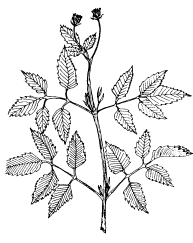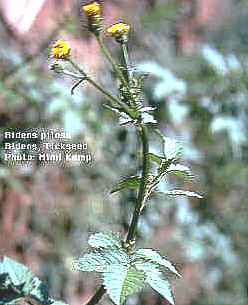


Family:
Asteraceae|
DESCRIPTION | |
| Properties/Actions: | Antibacterial, Antidysenteric, Anti-inflammatory, Antimicrobial, Astringent, Diuretic, Emmenagogue, Emollient, Hepatoprotective |
| Phytochemicals: | Acetylenes, B-amyrin, B-sitosterol, beta-D-glucopyranosyloxy-3-hydroxy-6(E)- tetradecen-8, 10,12-triyne, Esculetin, Flavoniods, Friedelin, Friedelan-3 beta-ol, Limonene, Linolic acid, Linolenic acid, Lupeol, Phenylheptatriyne, Phytosterin-B, Sterols, Tannins, tridecapentyn-1-ene, trideca-2,12-diene-4, 6,8,10-tetrayne-1-ol, trideca-3,11-diene-5,7,9-triyne-1,2-diol, trideca-5-ene-7,9,11-triyne-3-ol Volatile oil, Xanthophylis |

| COUNTRY |
ETHNOBOTANY WORLDWIDE USES |
| Amazonia | Ache(head), Ache(stomach), Ache(tooth), Aftosa, Angina, Chills, Diabetes, Diuretic, Dysentery, Dysmenorrhea, Edema, Emmenagogue, Hepatitis, Jaundice, Laryngitis, Sore(throat), Sore(mouth), Vulnerary, Worms, Wounds |
| Bahamas | Cancer, Carminative, Diuretic, Fever, Heat-Rash Itch, Sore |
| Brazil | Astringent, Blenorrhagia, Diabetes, Diuretic, Emollient, Fever, Jaundice, Leucorrhea, Liver, Liver(Obstructions), Sclerosis(Glands), Throat(Sore), Tonsilitis, Urinary Infections, Vaginal Infections |
| Dominican Republic | Diuretic, Emmenagogue, Lactogogue, Pectoral, Sialogogueue, Toothache |
| Elsewhere | Boil, Cold, Conjunctivitis, Cough, Dysentery, Eye, Food-Poison, Inflammation, Liver, Rheumatism, Stomach, Styptic, Toothache |
| Ghana | Allergy, Ear, Eye, Styptic, Urticaria |
| Haiti | Aftosa, Amygdalitis, Angina, Catarrh, Diabetes, Lactogogue, Stomatitis |
| Malaya | Antidote, Cough, Conjunctivitis |
| Mexico | Diabetes, Diuretic, Pectoral |
| Peru | Abscess, Anti-inflammatory, Childbirth, Conjunctivitis, Diuretic, Hepatitis, Hepatoprotective, Mycosis, Obesity, Urinary Infections, Weightloss |
| Philippines | Boil, Intoxicant |
| Upper Volta | Bite(Snake),Bronchitis, Colic, Cough, Diarrhea, Intestine |
| Venezuela | Dysentery, Vulnerary |
Footnotes:
J Ethnopharmacol 1997 Mar;56(1):81-87
Antibacterial
activity of South African plants used for medicinal purposes.
Rabe
T, van Staden J
Department of Botany, University of Natal Pietermaritzburg,
Scotsville, South Africa.
Crude extracts from 21 South African medicinal
plants, traditionally used for ailments of an infectious or septic nature, were
screened for in vitro antibacterial activity using the agar diffusion and
dilution methods. Almost all the activity exhibited was against Gram-positive
bacteria, with 12 of the 21 plant species tested showing some activity against
Bacillus subtilis. Only the Warburgia salutaris methanol extract inhibited the
growth of Escherichia coli. None of the extracts had any activity against
Klebsiella pneumoniae. The highest activity was found in the methanol extracts
from Bidens pilosa, Psidium guajava, Artemisia afra and Warburgia salutaris. The
majority of the antibacterial activity was present in the methanolic, rather
than the aqueous extracts.
Planta Med 1996 Aug;62(4):355-357
Bioactive
polyacetylenes from Bidens pilosa.
Alvarez L, Marquina S, Villarreal
ML, Alonso D, Aranda E, Delgado G
From the methanolic extract of the whole
plants of Bidens pilosa the new
beta-D-glucopyranosyloxy-3-hydroxy-6(E)-tetradecen-8, 10,12-triyne besides a
known polyine has been isolated and identified mainly by IR and NMR methods. The
new compound showed overgrowing action against normal and transformed human cell
lines in culture.
J Ethnopharmacol 1996 Jun;52(2):95-100
Screening of Zulu
medicinal plants for prostaglandin-synthesis inhibitors.
Jager AK,
Hutchings A, van Staden J
Department of Botany, University of Natal
Pietermarizburg, Scottsville, South Africa.
Aqueous and ethanolic extracts
of 39 plants used in traditional Zulu medicine to treat headache or inflammatory
diseases were screened for prostaglandin-synthesis inhibitors. Extracts were
tested in an in vitro assay for cyclooxygenase inhibitors. In general, ethanolic
extracts caused higher inhibition than aqueous extracts. Two-thirds of the
plants screened had high inhibitory activity. The highest inhibition was
obtained with ethanolic extracts of Bidens pilosa, Eucomis autumnalis,
Harpephyllum caffrum, Helichrysum nudifolium, Leonotis intermedia, L. leonorus,
Ocotea bullata, Rumex saggitatus, Solanum mauritianum, Synadenium cupulare and
Trichilia dregeana.
Am J Chin Med 1996;24(3-4):231-240
The hepatoprotective
effects of Taiwan folk medicine ham-hong-chho in rats.
Chin HW, Lin
CC, Tang KS
Foo Yin College of Nursing & Medical Technology, Kaohsiung,
Taiwan.
Bidens pilosa L. var minor (Blume) Sherff, B. pilosa L. and B.
chilensis DC (compositae), commonly known as "Ham-hong-chho" in Taiwan, have
been traditionally used for medicinal purposes. To clarify and compare the
hepatoprotective effects of these three plants, we evaluated their potential
effectiveness on CCl4- and acetaminophen-induced acute hepatic lesions in rats.
The results indicated that the increase in SGOT and SGPT activities caused by
CCl4 (3.0 ml/kg, s.c.) and acetaminophen administration (600 mg/kg, i.p.) could
be significantly reduced by treating with the extracts of all the three kinds of
"Ham-hong-chho" and the extract of B. chilensis exhibited the greatest
hepatoprotective effects. These phenomena were also confirmed by histological
observation. Liver damage induced by CCl4 and acetaminophen was markedly
improved in the extract of B. chilensis treated groups, while groups treated
with the extracts of B. pilosa var minor and B. pilosa demonstrated only
moderate protective effects. The pharmacological and pathological effects of
these three crude groups were compared with Bupleurum chinense, which has been
reported previously as a treatment criteria in the CCl4 model, and with
silymarin as a standard reference medicine in the acetaminophen model. The
results suggest that B. pilosa var minor, B. pilosa and B. chilensis can protect
liver injuries from various hepatotoxins and have potential as broad spectrum
antihepatic agents.
J Ethnopharmacol 1995 May;46(2):73-93
The
ethnopharmacology of Madeira and Porto Santo Islands, a
review.
Rivera D, Obon C
Departamento de Biologia Vegetal,
Facultad de Biologia, Universidad de Murcia, Spain.
The ethnopharmacology of
Madeira and Porto Santo Islands is extremely interesting because of the cultural
and biogeographic features of this region, which make it a centre of medicinal
plant diversity (richness of endemic flora, geographical isolation in the
Atlantic sea, crosscultural influences, and past abundance of local healers).
The medicinal flora of Madeira is composed of 259 species. Some noteworthy
medicinal taxa, endemic or locally relevant, are: Acanthus mollis, Aeonium
glandulosum, Aeonium glutinosum, Bidens pilosa, Borago officinalis, Chamaemelum
nobile var. discoideum, Culcita macrocarpa, Echium nervosum, Euphorbia
platiphylla, Helichrysum melaleucum, Helichrysum obconicum, Hypericum
glandulosum, Hypericum humifussum, Kleinia repens, Laurus azorica, Monizia
edulis, Ocotea foetens, Psoralea bituminosa, Rubus bollei, Rumex maderensis,
Sambucus lanceolata, Scilla maderensis, Sedum brissemoretii, Sedum farinosum,
Sedum nudum, Sibthorpia peregrina, Teucrium betonicum, Thymus caespititius,
Trifolium squamosum and Vaccinium padifolium...
Am J Chin Med 1995;23(3-4):273-278
Anti-inflammatory
activity of Taiwan folk medicine "ham-hong-chho" in rats.
Chih HW,
Lin CC, Tang KS
Foo Yin Junior College of Nursing and Medical Technology,
Kaohsiung, Taiwan. "Ham-Hong-Chho" is a folk medicine in Taiwan, derived from
the entire plants of Bidens pilosa L. var. minor (Blume) Sherff (Compositae), B.
pilosa L. and B. chilensis DC. The anti-inflammatory effect of aqueous extracts
of the three plants against paw edema induced by carrageenan and chronic
arthritis induced by complete Freund's adjuvant were determined in rats. The
results indicated that paw edema induced by carrageenan was significantly
decreased by treatment with aqueous extracts (150 or 300 mg/kg) of all three
plants (p < 0.05) and that the effect of Bidens pilosa var. minor was the
most potent. However, only extracts (500 mg/kg) of B. pilosa L. var. minor and
B. pilosa L. significantly decreased the paw edema induced by complete Freund's
adjuvant (p < 0.05).
Acta Pharm Hung 1991 Nov;61(6):317-323
Constituents and
biological activity of Bidens pilosa L. grown in Egypt.
Sarg TM,
Ateya AM, Farrag NM, Abbas FA
Department of Pharmacognosy, Faculty of
Pharmacy, University of Zagazig, Egypt.
Column chromotography and
preparative TLC of the light petroleum-diethyl ether extract from Bidens pilosa
L. afforded tridecapentyn-1-ene, trideca-2,12-diene-4,6,8,10-tetrayne-1-ol,
trideca-3,11-diene-5,7,9-triyne-1,2-diol and trideca-5-ene-7,9,11-triyne-3-ol.
The compounds were identified on the bases of UV, 1H-NMR spectra and comparison
with reported data. The chloroform extract was chromatographed to yield
B-amyrin, phytosterin-B, esculetin and B-sitosterol glucoside. The petroleum
ether extract afforded long chain ester, saturated hydrocarbon, long chain
alcohol, B-amyrin, phytosterin-B, lupeol and lupeol acetate. GLC analysis of the
fatty acids indicated the presence of 5 acids. The antimicrobial test was
carried out to indicate an evident activity. The antidiabetic activity showed
non significant decrease of blood glucose.
Acta Trop 1991 Feb;48(4):251-261
Constituents of Bidens
pilosa L.: do the components found so far explain the use of this plant in
traditional medicine?
Geissberger P, Sequin U
Institute for
Organic Chemistry, University of Basel, Switzerland.
The dried aerial parts
of Bidens pilosa L. were extracted with petrol ether, chloroform, methanol, and
methanol/water. The petrol ether and the methanol/water extracts showed some
antimicrobial activity. Fractionation of the extracts yielded well known
substances, most of which have, however, not yet been described as constituents
of Bidens pilosa. Several of these substances have previously been shown to be
biologically active. Thus, phenylheptatriyne, linolic acid and linolenic acid
have antimicrobial activities. On the other hand, friedelin and friedelan-3
beta-ol, as well as several of the flavonoids found are anti-inflammatory
agents. The detection of these compounds in extracts from B. pilosa may
rationalize the use of this plant in traditional medicine in the treatment of
wounds, against inflammations and against bacterial infections of the
gastrointestinal tract.
J Natl Cancer Inst 1985 Jun;74(6):1283-1290
Test of
catechol, tannic acid, Bidens pilosa, croton oil, and phorbol for
cocarcinogenesis of esophageal tumors induced in rats by
methyl-n-amylnitrosamine.
Mirvish SS, Salmasi S, Lawson TA, Pour P,
Sutherland D
Catechol (CAS: 120-80-9), given in drinking water to rats, was
the most effective of 5 phenols in enhancing [3H]thymidine incorporation [(
3H]dThd-l) into esophageal DNA. To test for esophageal cocarcinogenesis, groups
of 30 male MRC-Wistar rats received 3 weekly ip injections of 25 mg
methyl-n-amylnitrosamine [(MNAN) CAS: 13256-07-0]/kg. From the time of the first
MNAN injection, each group also received catechol, tannic acid (CAS: 1401-55-4),
dried leaves of Bidens pilosa L., or croton oil (CAS: 8001-28-3) (respectively,
2, 10, 50, and 2 g/kg semipurified diet), or were given 20 ip injections of 6 mg
phorbol (CAS: 17673-25-5)/rat. The rats were killed after 20-45, 46-52, or 53-72
weeks (subgroups A, B, and C). In the group given MNAN alone, most esophageal
papillomas developed during the first 45 weeks. Both catechol and B. pilosa
significantly increased the esophageal papilloma multiplicity (No. of
papillomas/rat) induced by MNAN, with a maximum tumor yield of 2.2 times that in
the corresponding subgroup treated with MNAN alone. Papilloma multiplicity
increased from subgroup A to subgroup C in the MNAN plus B. pilosa group but not
in the MNAN plus catechol group. No tumors were induced by the test
cocarcinogens given without MNAN. We concluded that a) an increased esophageal
[3H]dThd-I indicates potential cocarcinogenicity and b) catechol and B. pilosa
were weak esophageal cocarcinogens. These results support the view that catechol
in cigarette smoke and B. pilosa as eaten in South Africa contribute to the
etiology of human esophageal cancer.
J Nat Prod 1979 Jan;42(1):103-111
Ultraviolet-mediated
cytotoxic activity of phenylheptatriyne from Bidens pilosa L.
Wat
CK, Biswas RK, Graham EA, Bohm L, Towers GH, Waygood ER
The tropical weed
Bidens pilosa L. (Asteraceae) contains a number of polyacetylenes which are
phototoxic to bacteria, fungi, and human fibroblast cells in the presence of
sunlight, artificial sources of long-wave ultraviolet light, or cool-white
fluorescent light. The principle photoactive compound in the leaf,
phenylheptatriyne, is present in the cuticle as well as in the underlying cells.
Experiments with calf thymus DNA indicate that, unlike photoactive
furanocoumarins, phenylheptatriyne does not form interstrand cross linkages with
DNA in ultraviolet light.